<< Previous | Displaying results 6071-6080 of 6769 for "" | Next >>
Prewar portrait of Golda Tenin with her daughter Paulina, 1935. The Tenin family was living in the Ukrainian city of Odesa when it was occupied by Romania, an ally of Nazi Germany. In December 1941, Romanian authorities decided to make Odesa free of Jews. Two of Golda's children, Paulina and Rita, were murdered. Paulina was killed in January 1942, likely during deportation. Rita was killed after she was discovered in hiding with non-Jewish neighbors. Golda managed to survive.
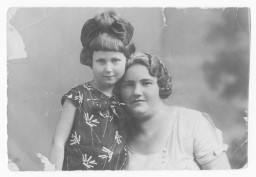
Garber family photograph, likely taken in Zehlendorf, Berlin, circa 1946. Magdalene Garber and her husband Jack Goodwin (an African American GI) had a house in Zehlendorf. This photo was most likely taken in their garden. Standing left to right are Käthe Garber (‘an aunt’ according to the original caption), Magdalene, Joseph Garber, and Helga Naue (future wife of Hans Garber). The man kneeling is Hans Garber (Magdalene's brother). Joseph is wearing Jack Goodwin’s hat (Magdalene's…
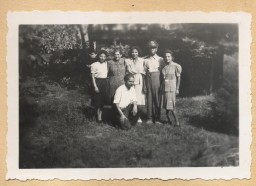
Josefa Boholle (Josefa van der Want after marrying her husband in 1943) sitting on the steps of a circus wagon with a bird on her shoulder. The photo was likely taken in Eisleben, Saxony-Anhalt, Germany, around 1936-1937. During World War II, Josefa and her Dutch husband were imprisoned in the Stutthof concentration camp. The official reason given for their arrest was for listening to foreign radio broadcasts. However, it is likely that the couple’s resistance activities and their interracial marriage…
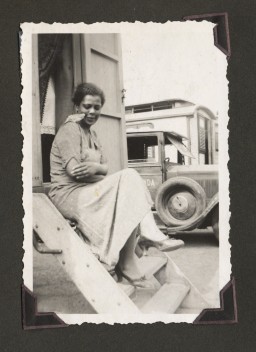
Members of the German Africa Show (Deutsche Afrika-Schau), circa 1937 in Germany. Though these early shows were exploitative by nature, artists originally had the ability to shape their own performances and how they were represented. After the Nazis came to power in 1933, this agency began to disappear. During the Nazi era, working in such shows was an increasingly propaganda-driven, demoralizing, and unpleasant experience. Known persons in the photograph from left to right: Josef Boholle is the furthest…
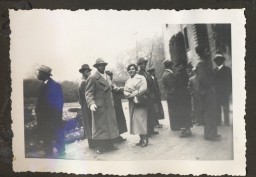
A group of female performers from the German Africa show (Deutsche Afrika-Schau) sitting on a circus wagon. This photo was likely taken in Eisleben, Saxony-Anhalt, Germany, around 1936-1937. Though early ethnographic shows like the Deutsche Afrika-Schau were exploitative by nature, artists originally had the ability to shape their own performances and how they were represented. After the Nazis came to power in 1933, this agency began to disappear. During the Nazi era, working in such shows was an…
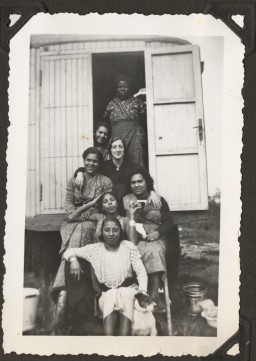
Best friends Ejanga Egiomue (left) and Magdalene Garber (right) on an outing in Berlin, Germany during World War II (likely 1941-1942). Magdalene stayed in Germany, but Ejanga fled to Denmark in 1944. Both women survived the war and stayed in contact with each other, exchanging letters and correspondence well into the 1990s. Magdalene (“Leni”) Garber was born in January, 1919 in Germany. Her parents were Joseph Garber, a Togolese man, and Johanna Maychrzak, a white German woman. Magdalene grew up in…
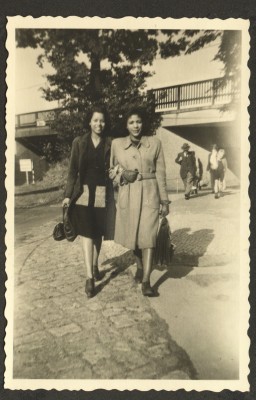
Magdalene Garber with friends and family at the public beach in Wannsee, Berlin, around 1940-1941. There are Nazi flags visible in the background behind Magdalene. Magdalene (“Leni”) Garber was born in January, 1919 in Germany. Her parents were Joseph Garber, a Togolese man, and Johanna Maychrzak, a white German woman. Magdalene grew up in Berlin-Neukölln and worked as a performer from an early age. She was part of several ethnographic shows, including a variety of Mohamed ben Ahmed’s Afrika-Schau…
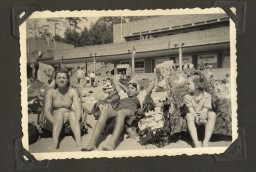
A wartime photograph of Magdalene Garber in the 1940s, likely taken in Berlin, Germany. Magdalene (“Leni”) Garber was born to Joseph Garber, a Togolese man, and Johanna Maychrzak in January 1919 in Germany. Magdalene grew up in Berlin-Neukölln and worked as a performer from an early age. She was part of several ethnographic shows, including a variety of Mohamed ben Ahmed’s Afrika-Schau during the late 1920s through the early 1930s, and the German Africa Show (Deutsche Afrika-Schau) during the Nazi…
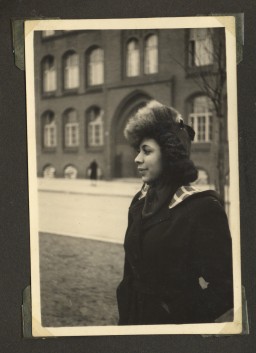
Party scene from the early 1940s in Germany. In the foreground is Deska Garber. Deska’s father was Joseph Garber, a Togolese man, and his mother was Johanna Maychrzak, a white German woman. The woman in the back left is Else Hummel, whom Deska would marry after the war. A small portrait of Adolf Hitler is visible on the wall in the background, something that would have been very common in German homes during the Nazi era.

This photograph shows a market scene at the main square in Lwów, Poland, shortly before the outbreak of World War II. Sitting on the fountain is a man holding a chicken and a basket, likely filled with groceries. His long beard and style of dress, including the overcoat and fedora, identify him as a more traditional, religious Jew. Traditionally, observant Jewish men wore beards and kept their heads covered. An elderly woman selling produce sits on the pavement near the man. In contrast to the man, the…
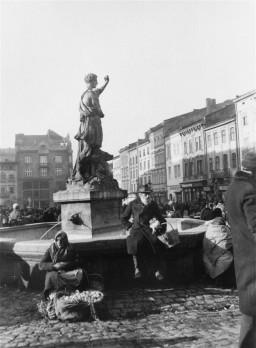
We would like to thank Crown Family Philanthropies, Abe and Ida Cooper Foundation, the Claims Conference, EVZ, and BMF for supporting the ongoing work to create content and resources for the Holocaust Encyclopedia. View the list of donor acknowledgement.